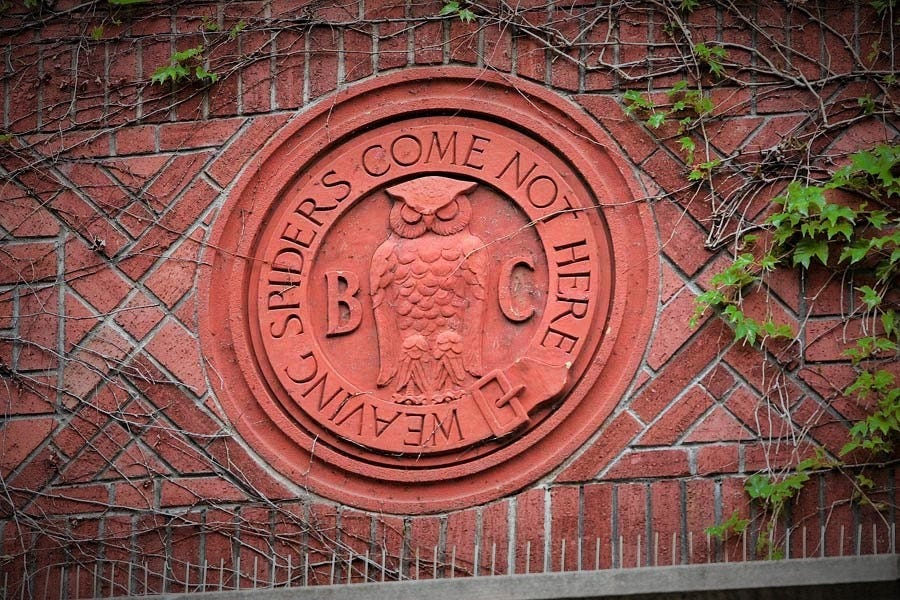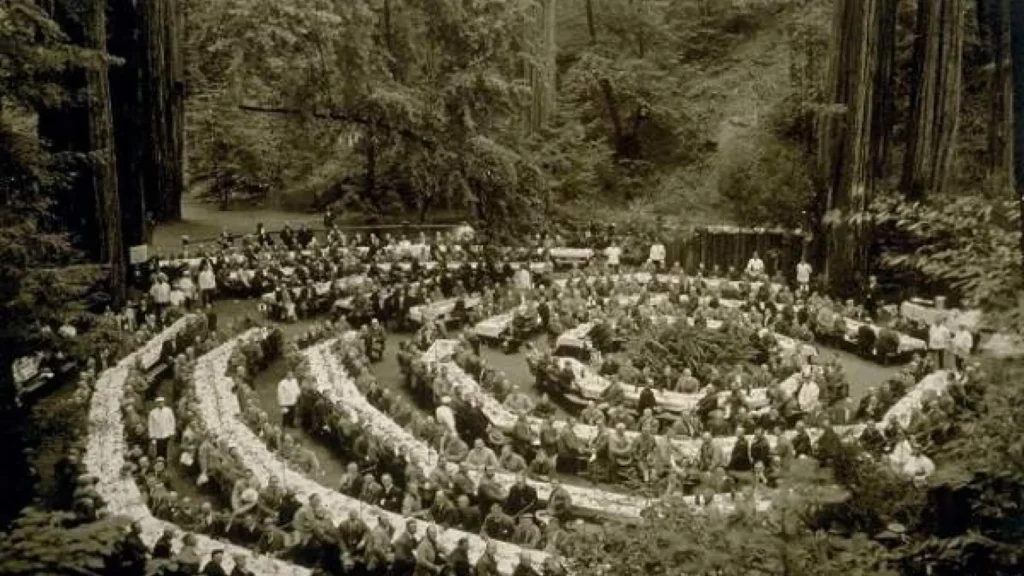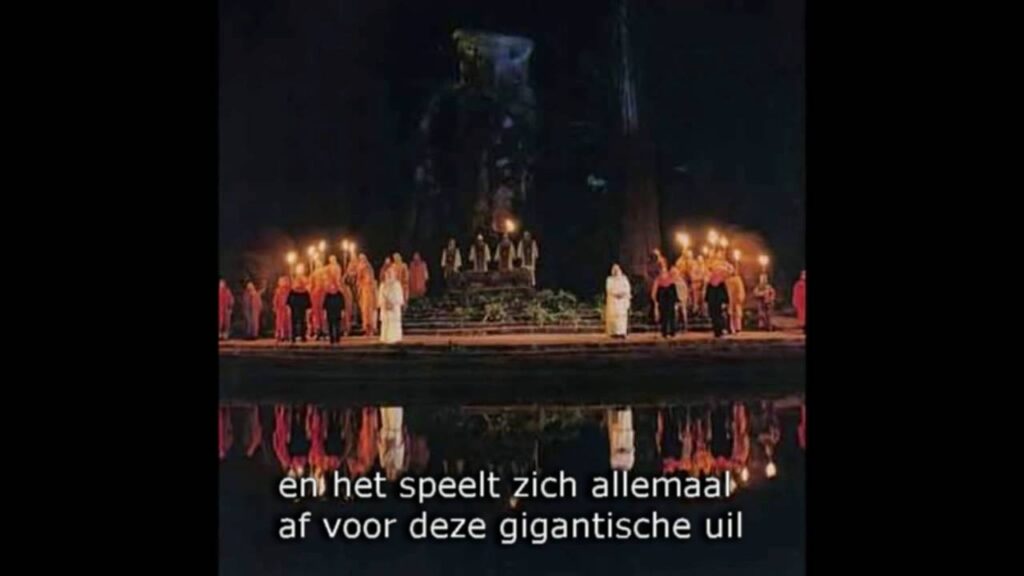Uncovering the Secrets of a Private Retreat Bohemian Grove is a private and exclusive retreat in Northern California’s redwood forests that has long been the focus of conspiracy theories. The annual gathering at Bohemian Grove has attracted influential figures from politics, business, and the arts ever since the Bohemian Club, an elite all-male organization based in San Francisco, started it in 1872. Numerous conspiracy theories have been fueled by the reports of strange rituals and activities and the secrecy surrounding these gatherings. The origins, fundamental beliefs, and debates surrounding the Bohemian Grove conspiracy theories are examined in this article.
1. The Bohemian Club

Owns the 2,700-acre campground known as Bohemian Grove, which can be found in Monte Rio, California. A group of journalists, artists, and musicians started the club in San Francisco, but it quickly expanded to include powerful businessmen, politicians, and other elites.
The Beginning: The original purpose of The Bohemian Club was to provide writers and artists with a place to meet, exchange ideas, and enjoy camaraderie. However, the club’s activities became more secretive as its membership grew to include powerful and wealthy individuals, and Bohemian Grove became the location of annual gatherings.
The Ceremony of “Cremation of Care”: The “Cremation of Care,” a ceremony that reportedly involves the symbolic burning of a human effigy in front of a 40-foot-tall owl statue, is one of Bohemian Grove’s most well-known and enigmatic rituals. Members are said to be able to unwind and enjoy their time at the retreat as a result of this ritual, which is said to symbolize the letting go of worldly worries and obligations.
Privacy and secrecy: The exclusiveness and strict privacy of Bohemian Grove are well-known. Members are prohibited from discussing what takes place during the gatherings and from having access to the media. The retreat’s actual activities have sparked conspiracy theories and speculation as a result of this secrecy.
2. Core Beliefs and Statements There are a number of conspiracy theories about Bohemian Grove, each with its own set of assertions and interpretations:

Global elite control: The idea that global elites gather at Bohemian Grove to discuss and plan global events is a common conspiracy theory. This theory asserts that the gatherings held at Bohemian Grove are more than just social occasions; rather, they provide opportunities for the world’s most powerful individuals to conspire and make decisions that influence global politics and economies.
Pagan and Occult Rituals: Some people have been led to believe that Bohemian Grove is a place of occult or pagan worship because of the “Cremation of Care” ceremony. The large owl statue, which is said to represent the ancient god Moloch or the goddess Minerva, is frequently cited as evidence of the group’s involvement in shady or occult practices.
Order in the World Bohemian Grove is linked, according to conspiracy theorists, to the New World Order, a covert global power structure aiming to establish a totalitarian global government. They argue that the people who went to Bohemian Grove to coordinate their efforts are key players in this alleged plan.
Satanic Ways of Life: According to more extreme theories, Satanic rituals with sacrifices and other sinister practices take place at Bohemian Grove. These assertions are frequently connected to broader conspiracy theories positing that the global elite is involved in evil deeds behind closed doors.
Deals in Politics and Commerce: According to a different theory, major business and political deals are made behind closed doors at Bohemian Grove. Backroom deals, according to critics, undermine democracy and permit powerful individuals to have undue influence over global affairs.
3. Criticism and Disprovement Numerous sources have criticized and disproved the conspiracy theories surrounding Bohemian Grove:

Context of culture and history: The “Cremation of Care” and other rituals and ceremonies held at Bohemian Grove can be thought of as theatrical performances that are rooted in the club’s long history of artistic expression. For instance, it is more likely that the owl statue is Minerva, a symbol of wisdom, rather than a pagan deity.
There is no evidence: There is insufficient evidence to support many of the more extreme claims, such as those regarding global conspiracies or Satanic practices. Journalists and researchers haven’t found any evidence that Bohemian Grove is engaging in unethical or illegal activities.
Social and political networks: While influential people do show up at Bohemian Grove, many of the gatherings are more likely to be social than conspiratorial. Instead of plotting to dominate the world, leaders can unwind at the retreat and have casual conversations.
Public Reports and Statements: The more sensationalist claims regarding Bohemian Grove have been publicly refuted by some attendees and former members of the Bohemian Club. They argue that the retreat is not a hub for secretive plots but rather a place for fun and camaraderie.
4. Impact on Culture and Society The conspiracy theories surrounding Bohemian Grove have had a significant impact on culture and society:

Cultural Context: Numerous books, documentaries, and media reports have made mention of Bohemian Grove, frequently portraying it as a symbol of elite power and secrecy. The retreat’s reputation as a place of intrigue has been helped along by the mystery surrounding it.
Public apathy: The public’s mistrust of the elite and the belief that influential people make decisions behind closed doors has grown as a result of Bohemian Grove’s secrecy. This mistrust is frequently connected to larger worries about accountability, democracy, and transparency in business and government.
Activism and Protests: Protests and activism have targeted Bohemian Grove, particularly from groups concerned about the influence of political and business elites. The lack of public oversight of powerful institutions, income inequality, and environmental degradation are all frequently brought to light by these protests.
Culture of Corruption: The theories that surround Bohemian Grove are a reflection of a broader cultural fascination with hidden power structures and secret societies. Fears about the concentration of power and the deterioration of democratic processes are fed by the possibility that a remote retreat could serve as the setting for global decision-making.
Conclusion
The Bohemian Grove conspiracy theories incorporate elements of elite power, ritual, and secrecy. Many of the more extreme claims lack evidence and are frequently based on misinterpretations, despite the retreat’s exclusivity and unusual ceremonies fueling speculation. Bohemian Grove remains a source of intrigue and debate, reflecting broader concerns about the impact of secrecy on public trust and the role of elites in shaping global affairs.



